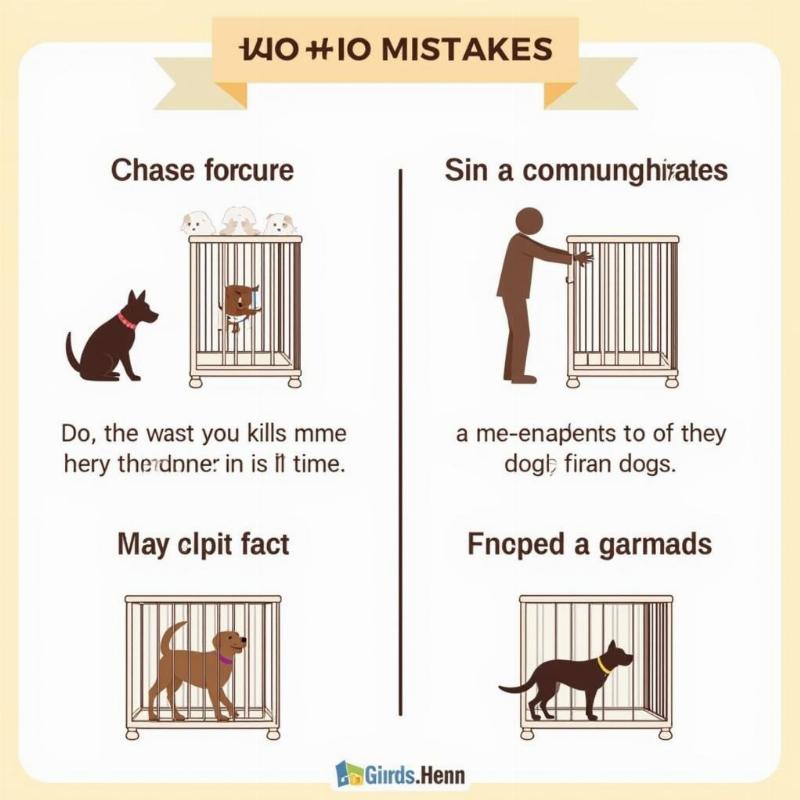A crate can be a powerful tool for managing anxiety in dogs, providing a safe and secure den-like space. However, using a crate for a dog with anxiety requires careful consideration and proper introduction. It’s not about locking your dog away, but about creating a positive association with the crate. This comprehensive guide will discuss how to effectively use a crate for dogs with anxiety, covering everything from choosing the right crate to establishing a positive crate training routine.
Understanding Canine Anxiety and the Role of a Crate
Dogs, like humans, experience anxiety. This can manifest in various ways, including destructive behavior, excessive barking, panting, pacing, and even self-harm. A crate for dog with anxiety can offer a sense of security and predictability, helping them cope with stressful situations. The key is to make the crate a positive and comforting space, not a punishment.
Choosing the Right Crate for an Anxious Dog
The size of the crate is crucial. It should be large enough for your dog to stand up, turn around, and lie down comfortably, but not so large that they feel lost or insecure. For example, a dog crate 48 x 30 x 33 inches might be suitable for a large breed, while a smaller crate would be appropriate for a smaller dog. Consider your dog’s breed, size, and individual needs when making your selection.
Crate Training an Anxious Dog: A Step-by-Step Guide
Introducing the crate should be a gradual and positive process. Start by making the crate inviting with soft bedding, toys, and treats. Leave the door open and allow your dog to explore at their own pace. Never force your dog into the crate.
Building Positive Associations
Encourage your dog to enter the crate by tossing treats inside. Feed your dog meals near or inside the crate. Gradually increase the time your dog spends in the crate, starting with short durations and gradually working up to longer periods.
Addressing Separation Anxiety with Crate Training
Crates for dogs with separation anxiety can be particularly helpful. However, it’s essential to address the underlying anxiety. Pair crate training with desensitization and counter-conditioning techniques to help your dog cope with being alone. dog crate for separation anxiety offers more specific guidance on this topic. You can also find further information on crates for dogs with separation anxiety.
Common Mistakes to Avoid
- Using the crate as punishment: This will create negative associations with the crate and worsen anxiety.
- Rushing the process: Patience is key. Allow your dog to adjust to the crate at their own pace.
- Leaving your dog in the crate for too long: This can increase anxiety and lead to behavioral problems.
 Common Mistakes in Crate Training
Common Mistakes in Crate Training
When to Seek Professional Help
If your dog’s anxiety is severe or you’re struggling with crate training, consult a certified professional dog trainer or a veterinary behaviorist. They can provide personalized guidance and develop a tailored training plan. crate for dogs with anxiety can provide you with additional resources. You might also want to check out best crates for dogs with anxiety for recommendations.
Conclusion
A crate for dog with anxiety can be a valuable tool when used correctly. It offers a safe haven and helps manage anxiety by providing a sense of security. Remember, patience, positive reinforcement, and a gradual introduction are crucial for successful crate training.
FAQ
- How long can I leave my dog in a crate? This depends on your dog’s age, breed, and individual needs. Adult dogs generally shouldn’t be crated for more than 6-8 hours.
- What if my dog cries in the crate? If your dog is crying out of distress, not just whining, let them out and try again later with shorter durations.
- Can I use a crate for a puppy with anxiety? Yes, but it’s crucial to introduce the crate gradually and make it a positive experience.
- What are some signs of anxiety in dogs? Signs include excessive barking, panting, pacing, destructive behavior, and changes in appetite.
- Is it cruel to crate a dog with anxiety? No, when used correctly, a crate can provide a sense of security and comfort for an anxious dog.
- What type of crate is best for an anxious dog? A sturdy, well-ventilated crate that allows your dog to see out can be beneficial.
- Should I cover the crate? Some dogs find a covered crate more den-like and secure, while others prefer it uncovered. Experiment to see what your dog prefers.
Related Articles
About Beautdogs.us
Beautdogs.us is your premier resource for all things dog-related in the US. We offer expert advice on dog breeds, care, training, and products. Whether you’re a new dog owner or a seasoned pro, Beautdogs.us provides trustworthy information to help you navigate the joys and challenges of dog ownership. Contact us for any inquiries: [email protected] or +1 501-555-7529.